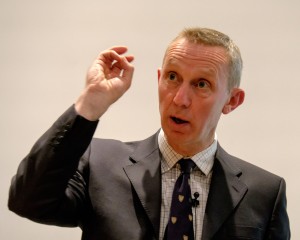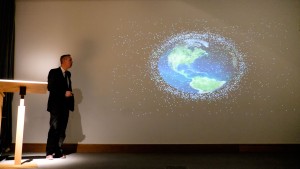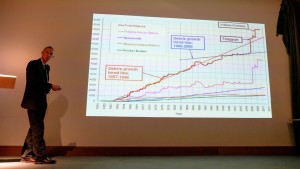April 13, 2015
Space Debris: How Dangerous Is It?
Professor Richard Crowther
Report by: Mike Meynell
After a gap of 4 years, it was a pleasure to welcome Professor Richard Crowther of the UK Space Agency back to the Flamsteed to give us an update on space debris and other issues surrounding the security of satellites in Earth’s orbit.
Richard began his talk by explaining that space is becoming congested, contested and competed. “Congestion” is a topic that we became familiar with in Richard’s previous talk to the Flamsteed. Part of the problem is that many objects reside in the geostationary ring, where satellites have the same orbital period as Earth and are therefore always at a fixed point in the sky.
“Contested…” is a “…polite word for space warfare”, Richard stated. China performed a test in 2007 to destroy one of their satellites, which resulted in a dramatic increase in the amount of fragmentation debris in orbit.
“Competition” refers mostly to the geostationary ring, where many countries are reserving and trading spaces in the ring, increasing the commercial pressures of putting satellites in orbit.
Richard explained that it was his job to deal with the three responses to these issues: safety (to deal with congestion in space), security (to deal with contesting) and sustainability (to make sure that sufficient resources are available).
Only 7% of objects currently in space are capable of moving under their own power, the rest of the objects are just junk. There are various regulations that govern how this junk is dealt with. If you want to get a license to put an object in orbit, you must ensure that any propellant left on a satellite is burnt up, ensure that the satellite or rocket bodies are dealt with at the end of their lives and avoid the release of objects into space during operations. Unfortunately, not all countries have the same regulations, and there has been an increase in the use of “flags of convenience” in order to avoid these regulations.
A number of telescopes and radars on Earth are continually tracking objects in orbit. We can track objects that are 10cm or more in diameter. We can detect smaller objects of about 1cm, but not track them. Very small objects can neither be detected nor tracked. Richard showed us a small piece of the Hubble solar array, which has been brought back from orbit and he kindly allowed to be passed around the audience. It was possible to see small pits in the array caused by impacts with microscopic debris. These impacts will obviously degrade the array over time, meaning that it has to be replaced.
The prediction of where objects are in Earth’s orbit in order to prevent collisions is obviously of critical importance, but this is only treating the symptoms of the problem. To get on top of the issues, it is necessary to look at the causes and increase the regulation of objects in space. From 1996 onwards, increased regulations have been put in place. This did have a marked effect on the growth of debris in space, until the 2007 Fengyun missile test and then a collision between an Iridium and Kosmos satellite in 2009. These events have taken us 50 or 60 years forwards in the predictions of debris in orbit. Richard did some work back in 2001 predicting how bad things would get by the year 2070. We are already at that point, due to these two events.
There are over 17,000 objects with a size of greater than 10cm in orbit (and are therefore trackable). This makes up about 99.93% of the mass of objects in orbit. Objects of a size between 1cm and 10cm (detectable) number over 400,000, but only make up 0.035% of the mass. The worrying number is that there are over 35 million objects (mostly undetectable) of less than 1 cm, again making up 0.035% of the mass. The key is to avoid the mass fraction moving down further, as this would translate into millions more objects, posing an increased hazard to satellites.
There are techniques for bringing objects back from orbit safely, without increasing the amount of debris – harpoons, nets, grapplers, and so on. Ground based lasers to slow objects in orbit can also be used, meaning that the object will eventually burn up in the atmosphere.
So, what is the difference between a mission to safely bring satellites back from orbit and space warfare? There is only one difference – intent. Systems to decrease debris could be built with the intent to use them in space warfare to destroy or disable satellites. There are other techniques, like hacking into satellites or interfering with communications. As a state, we have to develop rules of engagement to deal with potential attacks of this kind.
We are now very reliant on systems from space, such as the GPS system, weather forecasting and so on. It is clearly a worry that our civil systems could be considered a target for any adversary. Many developing states do not have as much dependence on space as we do. Getting a consensus on a global convention for space security is difficult, but it is something that Richard is working on with representatives of other countries at the United Nations.
We wish Richard the very best of luck in his future endeavours and thank him for a most informative and interesting talk to the Flamsteed.
Pictures from the Evening (by Mike Meynell):
Posted under: Flamsteed, Flamsteed Lecture, Meeting Report















You must be logged in to post a comment.